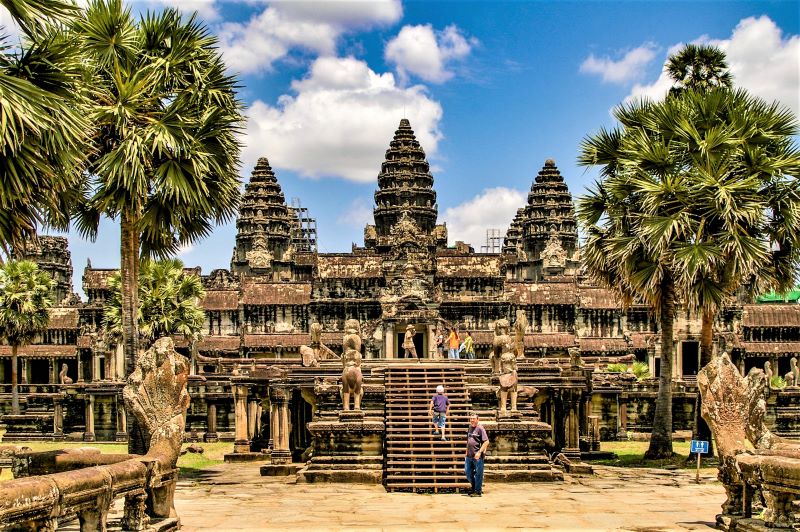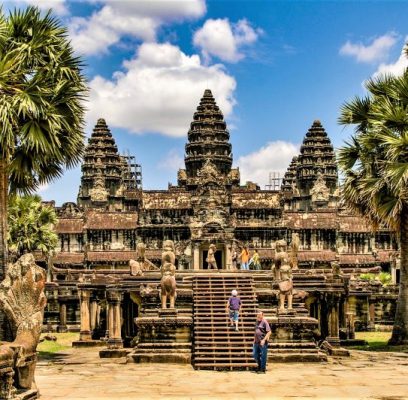Angkor Wat is a gathering of sanctuaries in Cambodia which is perhaps of the biggest strict landmark on the planet. The sanctuary which remains on a site covering an area of 1,626,000 m² was initially worked as a Hindu sanctuary of the Khmer Realm devoted to the god Vishnu, however continuously transformed into a Buddhist sanctuary towards the finish of the twelfth 100 years. Angkor Wat was worked by the Khmer Lord Suryawarman II in the mid twelfth hundred years in Yaśodharapura, the capital of the Khmer Realm, as the state sanctuary as well as the entombment spot of his remains. Not at all like the past rulers who were given to Master Shiva, Ruler Suryavarman II really fabricated Angkor Wat to be committed to Ruler Vishnu. As the most all around saved sanctuary in the Angkor sanctuary region, Angkor Wat is the main sanctuary that has stayed a significant strict focus since its foundation. This magnum opus of the exemplary style of Khmer design has become one of the images of the Cambodian state, highlighted on the Cambodian banner, and has turned into the country’s primary vacation spot.
Angkor Wat joins two fundamental plans of Khmer sanctuary engineering, to be specific the plan of the Gunungan sanctuary and the plan of the terraced sanctuary.
Read more : Botanic Square Singapore
Angkor, in Cambodia’s northern region of Siem Harvest, is one of the main archeological destinations of Southeast Asia. It reaches out over roughly 400 square kilometers and comprises of scores of sanctuaries, water driven structures (bowls, dykes, supplies, trenches) as well as correspondence courses. For a considerable length of time Angkor, was the focal point of the Khmer Realm. With noteworthy landmarks, a few different old metropolitan plans and huge water supplies, the site is an interesting convergence of highlights vouching for an outstanding civilization. Sanctuaries like Angkor Wat, the Bayon, Preah Khan and Ta Prohm, models of Khmer design, are firmly connected to their geological setting as well as being instilled with representative importance. The design and format of the progressive capitals demonstrate the veracity of an elevated degree of social request and positioning inside the Khmer Domain. Angkor is in this way a significant site representing social, strict and representative qualities, as well as containing high engineering, archeological and creative importance.
The recreation area is possessed, and numerous towns, some of whom the precursors are tracing all the way back to the Angkor time frame are dissipated all through the recreation area. The populace rehearses farming and all the more explicitly rice development.
Measure (I): The Angkor complex addresses the whole scope of Khmer craftsmanship from the ninth to the fourteenth hundreds of years, and incorporates various undeniable creative show-stoppers (for example Angkor Wat, the Bayon, Banteay Srei).
Measure (ii): The impact of Khmer craftsmanship as evolved at Angkor was a significant one over a lot of South-east Asia and assumed a central part in its unmistakable development.
Measure (iii): The Khmer Domain of the ninth fourteenth hundreds of years enveloped a lot of South-east Asia and assumed a developmental part in the political and social improvement of the locale. All that remaining parts of that progress is its rich legacy of clique structures in block and stone.
Measure (iv): Khmer engineering advanced generally from that of the Indian sub-mainland, from which it before long turned out to be obviously unmistakable as it fostered its own extraordinary attributes, some autonomously developed and others gained from adjoining social customs. The outcome was another imaginative skyline in oriental workmanship and engineering.

